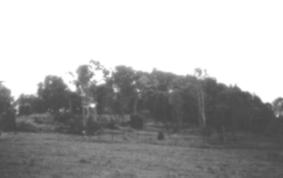A pre-Cook Shipwreck?
By Murray Byfield
For over 160 years the legend of a mysterious shipwreck along Victoria’s so called Shipwreck coast has seized the public imagination. The existence of the ship has never been confirmed and it has not been sighted again since the 1880’s. However amateur archaeologists and enthusiasts continue the search for the vessel.
If found the Mahogany Ship could change the way we think about the discovery of our Great Southern Land.
The first sightings of an old wreck in the area were recorded on January 18, 1836, when a party of three whalers from Port Fairy traveled to the mouth of the Hopkins River in search of seals. Their boat overturned and one man drowned. The two survivors walked back to Port Fairy along the coast. About halfway they discovered a ship wrecked in the dunes. They reported their find to Captain John Mills, in charge of the whaling station. He visited the wreck and described its “hard dark timber – like mahogany”.
There were many wrecks in the area during this period but the unusual and distinguishing features of the Mahogany Ship were its distance from the water’s edge and its unusual construction. The last sighting of the mysterious dark timbers of the Mahogany Ship was during the 1880s. Many theories on the Mahogany Ship’s origin have been proposed.
The most popular and exciting of these argues that the vessel is of Portuguese origin and was wrecked in 1522. Very old Portuguese charts have since been discovered that depict Australia’s southern coastline as as far as Armstrong Bay, six kilometres west of Warrnambool. These charts suggest a Portuguese voyage to Australia in 1522. Some historians believe the Mahogany Ship was a Portuguese caravel captained by Christovao Mendonca, which was lost in the early 1500s.
Unearthing the Mahogany Ship could rewrite Australian history. But discovering the ship will be no easy task. The introduction of European pests and animals in the 1830s and 1840s caused destabilisation of the sand dunes. Massive sand drifts resulted, destroying the coast road and consuming large tracts of grazing land. These drifts are blamed for the disappearance of the Mahogany Ship. The true origin of the ship will remain conjecture until the wreck is rediscovered. Many have tried and failed. The State Government even offered a $250,000 reward to anyone who could find the vessel.
Some researchers have speculated that the ship was a modified Chinese junk. They point to the reports that it was made of a ‘dark wood’ and was ‘of an unconventional design’. There are claims that local Aborigines had a tradition that “yellow men” had at one time come from the wreck.
In July 1999, shipwreck enthusiast, Mr Des Williams, discovered a sample of wood buried 3.1 metres under the sand dunes between Warrnambool and Port Fairy.
It was identified by the CSIRO as Quercus species – White Oak. According to the CSIRO, “This wood is from a group of oaks and could have originated from the USA or Europe. It is a common shipbuilding timber.”
As Oak was a common shipbuilding material in colonial times other theories suggest that the Mahogany ship could be;
* A sealing and whaling vessel. Historical records suggest that sealing and whaling activities were going on along the Victorian coast before official settlement of the area. Oak was a common ship building material used by sealers and whalers.
* There are a number of documented cases where convicts from Van Diemen’s Land seized wooden vessels to escape across Bass Strait. The wreck may have been the remains of one such attempt.
* The wreck may have been from the 17th Century. The Dutch were sailing to the “Spice Islands” and many reached the Western Australian coast – it is even possible that one may have come to rest at Warrnambool.
In September 2005 Mark Rawson, an amateur archaeologist, spoke at the Mahogany Ship symposium. “It was quite an interesting symposium… the general consensus was that there may well be more than one ship,” he says.
Presented at the symposium was Dr Frank Conningham’s research of Australia’s early Constitution. His research suggests a Portuguese ship had been sighted off the coast, but had been disposed of by the British in a nearby swamp before 1850. There have been claims by eyewitnesses that a ship was seen after 1850.
This confirmed Mark’s theories of more than one ship being sighted along the shipwreck coast in the 1800s. “We’ve come to the conclusion that they’ve probably seen different ships,” he says.
There is further evidence of more than five ships being wrecked along the Warrnambool coast, “Which tends to suggest that they were all coming here for a reason. We have a vague suspicion that there may have been an old settlement there. It may explain why a number of ships have ended up on that beach,” he says.
What does this new information mean for the Mahogany Ship digs?
“We have a vague suspicion that we know roughly were it is now. We have to do a little more investigation, but it basically means that we can now look in a different location that no one has ever looked in before,” he says.
The legend of the Mahogany Ship has become so popular that a tourist walk has been created. Visitors can wander the Mahogany Ship Walking Track which follows the coast for the 23 kilometres between Warrnambool and Port Fairy. It passes the possible site of the Mahogany Ship and many other shipwrecks.
Sources:
http://www.greatoceanrd.org.au/highlights/legends/mahogany.asp
http://www.wikipedia.org
http://www.abc.net.au/southwestvic/stories/s1468396.htm
http://www.heritage.vic.gov.au/page.asp?ID=121


